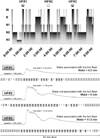Magnitude of the impact of hot flashes on sleep in perimenopausal women
- PMID: 25256933
- PMCID: PMC4252627
- DOI: 10.1016/j.fertnstert.2014.08.016
Magnitude of the impact of hot flashes on sleep in perimenopausal women
Abstract
Objective: To quantify the impact of objectively recorded hot flashes on objective sleep in perimenopausal women.
Design: Cross-sectional study. Participants underwent 1-5 laboratory-based polysomnographic recordings for a total of 63 nights, including sternal skin-conductance measures, from which 222 hot flashes were identified according to established criteria. Data were analyzed with hierarchical mixed-effect models and Spearman's rank correlations.
Setting: Sleep laboratory.
Patient(s): Thirty-four perimenopausal women (age ± SD: 50.4 ± 2.7 years).
Intervention(s): None.
Main outcome measure(s): Perceived and polysomnographic sleep measures (sleep quality, amount of time spent awake after sleep onset, and number of awakenings). Subjective (frequency and level of bother) and objective (frequency and amount of hot flash-associated awake time) hot-flash measures.
Result(s): Women had an average of 3.5 (95% confidence interval: 2.8-4.2, range = 1-9) objective hot flashes per night. A total of 69.4% of hot flashes were associated with an awakening. Hot flash-associated time awake per night was, on average, 16.6 minutes (95% confidence interval: 10.8-22.4 minutes), which accounted for 27.2% (SD 27.1) of total awake time per night. Hot flash-associated time awake, but not hot flash frequency, was negatively associated with sleep efficiency and positively associated with waking after sleep onset. In addition, self-reported wakefulness correlated with hot flash-associated waking, suggesting that women's estimates of wakefulness are influenced by the amount of time spent awake in association with hot flashes during the night. Having more perceived and bothersome hot flashes was correlated with more perceived wakefulness and awakenings and more objective hot flash-associated time awake and hot-flash frequency.
Conclusion(s): The presence of physiological hot flashes accounts for a significant proportion of total objective time awake during the night in perimenopausal women.
Keywords: Hot flash; menopause; polysomnography; skin conductance; sleep.
Copyright © 2014 American Society for Reproductive Medicine. Published by Elsevier Inc. All rights reserved.
Conflict of interest statement
Figures


References
-
- Kronenberg F. Hot flashes: epidemiology and physiology. Ann N Y Acad Sci. 1990;592:52–86. - PubMed
-
- Melby MK, Anderson D, Sievert LL, Obermeyer CM. Methods used in cross-cultural comparisons of vasomotor symptoms and their determinants. Maturitas. 2011;70:110–119. - PubMed
-
- Freedman R. Physiology of hot flashes. Am J Hum Biol. 2001;13:453–464. - PubMed
-
- Moe K. Hot flashes and sleep in women. Sleep Med Rev. 2004;8:487–497. - PubMed
-
- Ameratunga D, Goldin J, Hickey M. Sleep disturbance in menopause. Intern Med J. 2012;42:742–747. - PubMed
Publication types
MeSH terms
Grants and funding
LinkOut - more resources
Full Text Sources
Other Literature Sources
Medical

